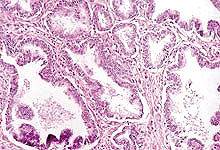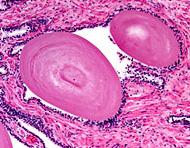 Examine sections of prostate gland.
Identify the tall epithelial cells with lightly stained "foamy"
cytoplasm at the apical ends and in the stroma notice
the smooth muscle fibers (red) mixed with dense connective tissue
(blue). In the lumen identify the calcified, proteinaceous
concretions called corpora amylacea. Examine sections of prostate gland.
Identify the tall epithelial cells with lightly stained "foamy"
cytoplasm at the apical ends and in the stroma notice
the smooth muscle fibers (red) mixed with dense connective tissue
(blue). In the lumen identify the calcified, proteinaceous
concretions called corpora amylacea.
How does benign prostate hyperplasia,
BPH, which is common in older men, cause medical problems?
 Clinical note: Prostate glands
provide urologists with plenty of work by being prone to three very
common problems: (1) They are the site of chronic, low-grade
bacterial infections. (2) In older men the secretory epithelium very
frequently undergoes benign hyperplasia, resulting in so much tissue
overgrowth that the urethra is often constricted and there are
problems with urination. (3) Adenocarcinoma of the prostate
epithelium is now the most common form of cancer in men. Clinical note: Prostate glands
provide urologists with plenty of work by being prone to three very
common problems: (1) They are the site of chronic, low-grade
bacterial infections. (2) In older men the secretory epithelium very
frequently undergoes benign hyperplasia, resulting in so much tissue
overgrowth that the urethra is often constricted and there are
problems with urination. (3) Adenocarcinoma of the prostate
epithelium is now the most common form of cancer in men.
The penis and
urethra. |